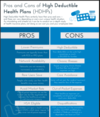H&S Flashcards
Premium
Amount you pay for your health coverage (usually each month), does NOT count toward your deductible or out-of-pocket maximum
Deductible
Amount you pay for COVERED services each year before your plan starts ex: you plan has $500 deductible, so you pay the full charges for COVERED services up to $500 and then you just pay a copay or coinsurance for each visit
Copay
set amount you pay for COVERED services ex: a doctor visit costs $120, you pay a $20 copay when you visit the doctor and your insurance covers the rest ($100)
Coinsurance
A percentage of the charges that you pay for COVERED services ex. you pay 20%, employer covers the rest
Out-of-pocket maximum
The is the most you’ll pay for COVERED services each year. if you reach you maximum, you won’t pay out-of-pocket costs for COVERED services for rest of the year.
Impacts of cost-sharing
“skin in the game”: reduction of moral hazard of overutilization by making patients contribute reduction of premiums: in general the higher the cost-sharing per utilization the lower the plans premiums high cost-sharing can lead to reduced access to care and delays in dx/tx
Why do large-employers self insure?
Self-funded vs. Fully insured:
- Payments: employer does not pay premiums, instead it pays fixed costs of administration and employee health care claims VS. employer pays monthly premiums to an insurance carrier
- Risk: employer assumes risks VS. insurance company assumes risks
- Plan design: employers have more control and freedom VS. employers are limited by insurers plan design options
- Compliance payments: ERISA law pre-empts state regulations VS. plan must comply with state regulations

Self-funded /self-insured plans and mid-sized group plans must cover:
60% of employee costs to avoid penalites, wide variations in the services they will cover, essential helath benefits not required **a percentage of costs**
Individual and small group plans must cover:
Essential Health Benefits **A certain list of services**
What happens to your health insurance if you leave your job?
COBRA (Consolidated omnibus budget reconciliation act of 1985) allows continuation of health insurance after seperation from employer typically 18 months, extensions possible individual now has to pay both the employer and the employee portion of premiums! yikes.
Types of private insurance by structure: Idemnity health insurance (1)
- Indemnity health insurance: endangered species, fee for service, “unmanaged care”, insurer pays a percentage of bill, no networks no referrals no CP requirement, generally more expensive
- Managed Care (PPO, EPO, POS, HMO): insurance companies trying to actively manage the care patients seeking, different types of management
- High Deductible Health Plans: you have high deductible but lower premiums, great plan if you don’t use much health care, con is care avoidance, encourages “shopping around”, becoming more and more common

Types of private insurance by structure: Managed Care (2)
- Indemnity health insurance: endangered species, fee for service, “unmanaged care”, insurer pays a percentage of bill, no networks no referrals no CP requirement, generally more expensive
- Managed Care (PPO, EPO, POS, HMO): insurance companies trying to actively manage the care patients seeking, different types of management
- High Deductible Health Plans: you have high deductible but lower premiums, great plan if you don’t use much health care, con is care avoidance, encourages “shopping around”, becoming more and more common

Types of private insurance by funder

Types of private insurance by structure: High deductible health plans (3)
- Indemnity health insurance: endangered species, fee for service, “unmanaged care”, insurer pays a percentage of bill, no networks no referrals no CP requirement, generally more expensive
- Managed Care (PPO, EPO, POS, HMO): insurance companies trying to actively manage the care patients seeking, different types of management
- High Deductible Health Plans: you have high deductible but lower premiums, great plan if you don’t use much health care, con is care avoidance, encourages “shopping around”, becoming more and more common



